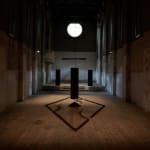
Paul Purgas
Further images
The central floor piece draws inspiration from the Indian craft tradition of the alpana, a method of symbolic design which often incorporates geometries and patterns drawn from nature, and made from simple materials such as powder or grains. The system emerged from early folk origins as a means to ward away evil spirits and evolved into an early modernist form of collective making and knowledge sharing central to the pedagogy of Rabindranth Tagore’s eco-concious school Shantiniketan. The improvised form devised within the space contrasts hard and soft geometries, bringing together organic forms, relief and lines. The minimalist pattern integrates with the central speaker’s rotation to create a kinetic mandala. The form was constructed from soil gathered locally from Southwark park, and was returned to the grounds after the exhibition was completed, an ephemeral gesture integrating the Indian Modernist tenets of environmental awareness and the harmonic considerations of nature within the act of making - ‘ideas travel but material and labour remain local’
The sound compositions incorporate two ragas that are significant to the summer period of the exhibition duration, Raga Multani associated with the heat of the season and Raga Desh that is played to evoke the monsoons that break the summer droughts. The sonics anchor the work within the seasonal and temporal space of its context, likewise considering the non linear time theories of music present within the Indian classical music tradition, and the anchoring of South Asian sonic histories within a dialogue with the natural cycles of the earth and environment.
The vocal contributions to the arrangement were made by Purgas’s own guru, the Hindustani singer Ranjana Ghatak, an acknowledgement of the continuum of oral transmissions of knowledge, embodied praxis and musicality, that have resisted Western ideological method of written canonised composition.
A triptych of speakers act as a brief intermission to the piece, these were developed from three elements, an assembly of speeches across the late 20th century by the Indian spiritual philosopher Jiddu Krishnamurti discussing the relationship between consciousness, nature and technology, an arrangement of environmental field recordings captured by Purgas both locally and across sites in India, and a composition developed from a sound workshop for young people in London around the local area, a mirroring of the possibilities of pedagogy and making to exist hand in hand through education and knowledge sharing.
